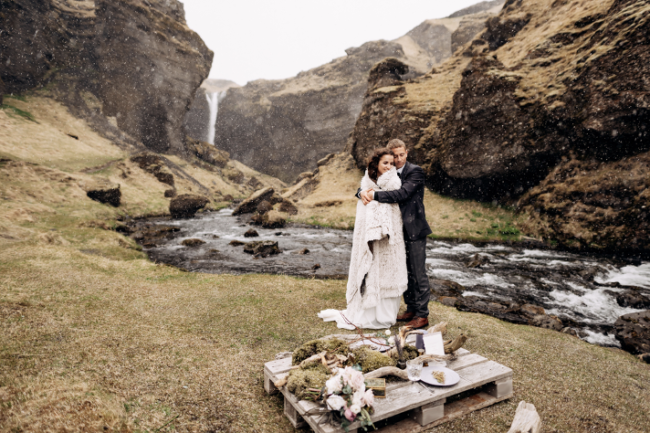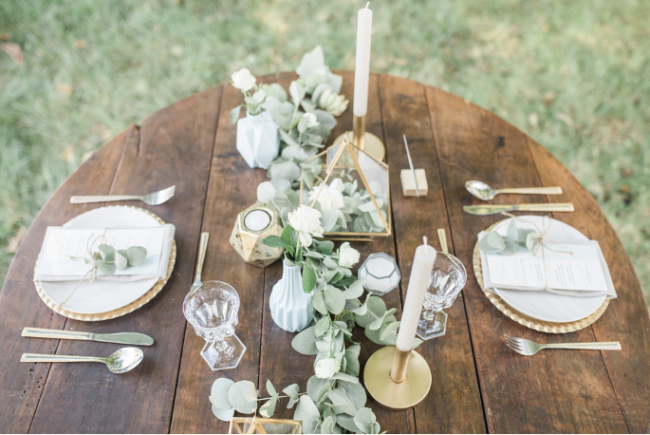Some of the most popular months for weddings are May, June and October. With lots of sunlight and ideal temperatures, these months are jam-packed with weddings and elopements. For some couples, the idea of standing outdoors in the sweltering heat or risking a hurricane ruining the wedding doesn’t seem appealing—and couples who want a unique wedding date they don’t share with anyone else instead turn to spring dates.
But, with rampant allergies and a rainy season, many couples feel they’re “stuck” with a winter wedding instead. You shouldn’t feel stuck if you’re considering a winter marriage—in fact, winter weddings can be fun and unique! If you’re planning a wedding elopement, here are a few things to keep in mind.
- Keep the Cold in Mind: The temperature during the winter is important. If you’re not eloping on an island in the Caribbean, then you’re probably going to experience some colder temperatures or some harsher, frosty weather. In this case, you should make sure to prepare for it.
- Avoid Metal Rings: Instead of wearing metal rings during your elopement, go for an alternative! Options such as durable silicone rings are perfect for winter outdoor elopements. You don’t have to worry about the cold weather causing your rings to slip off, and your rings will make it through any hike or physical activity to get to and from your elopement site.
- Wear Layers: Make sure you dress appropriately for any cold weather. Mittens, gloves, hats, coats—you’ll want to wear clothes that will keep you warm as you trek out into the cold. Enlist your witnesses for your elopement to hold your clothes briefly while you pose for bridal portraits in your gown and suit. Alternatively, you could wear comfortable clothes for your elopement, and then get bridal portraits done inside a venue or at a later date!
- Consider Your Guests and Vendors: Hiring a videographer or photographer? Having your parents attend as witnesses? These are a couple of things you should keep in mind as you plan your winter elopement. If it’s too cold outside for your grandmother, you might want to reconsider who will serve in her place as one of your witnesses. And, while every photographer out there is looking for more ways to expand their portfolio, you ensure they’re probably prepared to take on the cold with you.
- Plan Where, When and How: It’s important, as you plan your elopement, to consider where you want to host it. On the top of a mountain? At the edge of a lake? Depending on where you want to elope, you might be restricted in when and how you get there. Many outdoor parks, hiking trails and water features close down or operate on restricted days and hours to accommodate the cold weather and snow. Make sure you check the locations’ websites and social media pages for information on closures or operating hours before choosing your elopement date, time and location!
 MONTENEGRO/Shutterstock.com
MONTENEGRO/Shutterstock.com
- Know the Difference Between an Elopement and a Wedding: These days, people are turning to elopements rather than weddings. Weddings can be very expensive, especially when it comes to catering and venues. If you’re wondering how much it costs to elope versus having a small wedding, it’s important for couples to understand the difference between the two.
An elopement is where you and your fiance get married with an officiant and two friends, family members or other witnesses and without anyone else around. Some couples think a wedding with themselves, the officiant and fewer than 50 people is an elopement. In truth, they’re just having a small wedding.
If the idea of leaving your closest friends and family out of the celebration doesn’t match with what you want, then that’s okay! Just remember that you’re having a small wedding and not an elopement. If you are worried about cost, then have a small hors d’oeuvres cocktail hour after the ceremony. They’re typically much more budget-friendly and free up your guests’ evening.
However, if the idea of having an intimate ceremony of just you, your fiancé, two of your parents or friends or other witnesses, and the officiant is exactly what you want, then an elopement is for you! Some states even allow for self-solemnizing, where you and your partner marry yourselves without an officiant. This is a great opportunity for couples who want to have a unique marriage experience—elopements and weddings alike!
- Consider Travel and Timing: During the winter season, an elopement might be a better option to actually get married, and then have a reception later in the warmer months. The snow and ice can severely impact travel for any family or friends who’d be traveling out of town for the big day. If you want to have a destination ceremony somewhere tropical and warm, it’s usually cheaper to travel during the winter as well. By considering the travel needed to get to your ceremony site, as well the timing of your elopement, you’ll have a much more seamless event!

- Have Food Prepared: Whether it’s a meal prepared by a private chef or one of your family members after the elopement, you’ll want to have something warm to eat and drink after spending time out in the cold for your ceremony and pictures. There are lots of ways you can have food prepared, and you can even reserve a table at a local restaurant! Tell them you’re eloping and would like to celebrate with your new spouse at their restaurant, and the staff might even include some romantic candles and a dessert for you both.
- Be Flexible: One of the main things you can do if considering a winter elopement is to be flexible. Just like with any other season, natural events occur. A huge blizzard could come rolling in, or it could be unexpectedly icy that day. Understand that everyone might not be available, and be open to your photographer suggesting locations and places to get married or where to take your bridal portraits. Either way, the most important thing is that you get married to the love of your life when and how you want.

